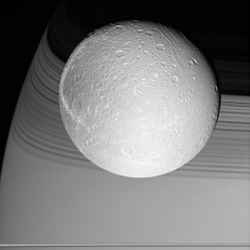
Saturn’s Moon Dione. Image credit: NASA/JPL/SSI Click to enlarge
Cassini prepared for its rendezvous with Dione on Oct. 11, 2005, capturing the brilliant, cratered iceball in front of its shadow-draped planet.
The terrain seen here becomes notably darker toward the west, and is crosscut by the bright, fresh canyons that form wispy markings on Dione’s trailing hemisphere. Dione is 1,126 kilometers (700 miles) across.
The image was taken in visible light with the Cassini wide-angle camera at a distance of approximately 24,500 kilometers (15,200 miles) from Dione and at a Sun-Dione-spacecraft, or phase, angle of 22 degrees. The image scale is about 2 kilometers (1 mile) per pixel.
The Cassini-Huygens mission is a cooperative project of NASA, the European Space Agency and the Italian Space Agency. The Jet Propulsion Laboratory, a division of the California Institute of Technology in Pasadena, manages the mission for NASA’s Science Mission Directorate, Washington, D.C. The Cassini orbiter and its two onboard cameras were designed, developed and assembled at JPL. The imaging operations center is based at the Space Science Institute in Boulder, Colo.
For more information about the Cassini-Huygens mission visit http://saturn.jpl.nasa.gov. The Cassini imaging team homepage is at http://ciclops.org .
Original Source: NASA/JPL/SSI News Release
